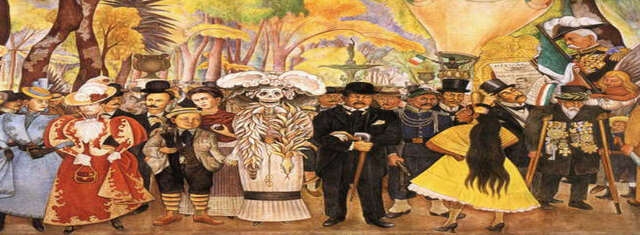Arts
Diego Rivera’s Dream Turns Into A Reality
City of Art

Dream of a Sunday Afternoon in Alameda Park (Source: Fine Art America)
USPA NEWS -
Diego Rivera created many masterpieces, but he envisioned a work of art that never came to be in his lifetime, a City of Art, where Mexican artists of all ages and disciplines could come to study, showcase, and celebrate the art of their diverse cultural heritage.
Rivera is famous for his use of Cubism in large public murals like The History of Mexico, The Allegory of California, and the Man at the Crossroads, commissioned by the Rockefellers, but it was after a long and storied career that he bought land in a suburb of Mexico City to built his vision City of Art.
Now 65 years after his death, Rivera’s image has finally come to life. A 64,000 square-foot complex south of the capital, the City of Arts centers around an Aztec temple-inspired museum built of volcanic rock from Xitle Volcano which erupted in 400 B.C., in which Rivera’s personal collection of more than 50,000 pre-Hispanic artifacts are housed. In 1941, back from a trip to San Francisco, Rivera began the construction of the Anahuacalli Museum, where he sought to generate continuity between modern art and pre-Columbian aesthetics.
Opened in 1964 as the centerpiece of his imagined City of Arts, it is now finally surrounded by 13 additional structures which were built over six years at a cost of more than a million dollars, completing Rivera’s original scheme. The spaces include galleries, performance spaces, workshops, and new offices, all built by one of Mexico City’s most-renowned architecture firms, Taller de Arquitectura, “to bring together the artist of the school and the academy with the potter, with the weaver, with the basket maker, with the stonemason, with everything that is a pure expression of the people of Mexico”, according to the Rivera’s own words. “The idea is that, as in pre-Columbian cities, the buildings gradually connect and allow the relationship between the parts. The buildings are built of volcanic stone walls and lattices, light atmospheres that already existed in Diego’s main building,” Mauricio Rocha, the chief architect behind the project, told El País. “In addition, with the new technologies that we use, it seems that the buildings sail in a kind of sea of lava.”
The openings of the new areas, including the experimental space The Piedra, took place in October last year to coincide with the Day of the Dead festival, and hosted an earth festival that focused on pottery, and other outdoor installations and concerts.
Thank you for reading my article. These are merely my thoughts and insights based on the facts. I use only verified sources. No fake news here. I write about a variety of subjects, mainly things I want to research and know more about. You can check out my website – Small Village Life at smallvillagelife.com, where I share useful articles and news.
Wendy writes for the United States Press Agency and is a former columnist with the Fulton County Expositor, Wauseon, Ohio.
Source: El País
Wendy writes for the United States Press Agency and is a former columnist with the Fulton County Expositor, Wauseon, Ohio.
Source: El País
more information: https://smallvillagelife.com
Liability for this article lies with the author, who also holds the copyright. Editorial content from USPA may be quoted on other websites as long as the quote comprises no more than 5% of the entire text, is marked as such and the source is named (via hyperlink).





